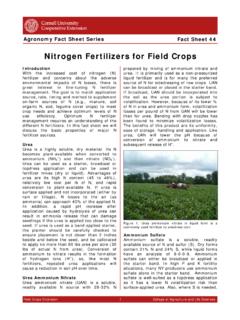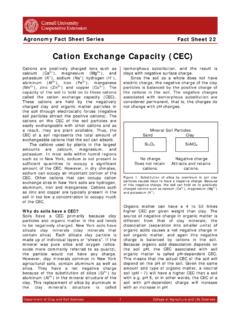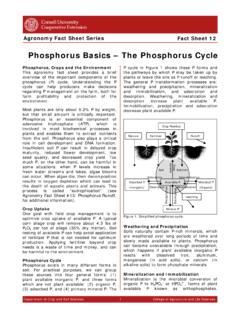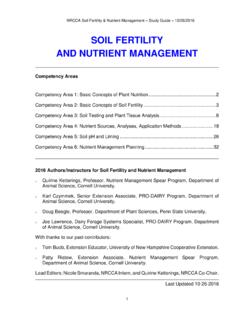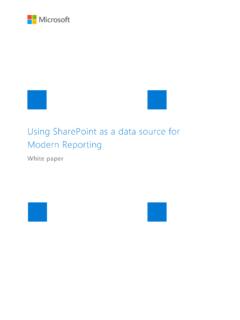Transcription of Phosphorus Soil Testing Methods - Cornell University
1 Agronomy Fact Sheet Series Fact Sheet 15. Phosphorus soil Testing Methods Cornell University annually publishes the Maine, Vermont, Connecticut, and Rhode Cornell Guide for Integrated Field Crops Island. The Morgan and Modified Morgan soil Management . This document includes tests give similar results as long as the soil to Phosphorus (P) fertilizer guidelines for a large solution ratio, scoop sizes, shaking time, filter number of field crops grown in New York. The paper, and instrumentation used to determine guidelines are based on field research in New P concentration in the extracts, are identical York that shows that the Morgan soil test, the and samples are corrected for weight and agronomic soil test used at Cornell University , moisture content. can be used to predict likeliness of a yield response to additional P for crops grown under New York growing conditions.
2 What is an agronomic soil test? The agronomic P soil test is an index of P. availability which means that we can use the soil test to determine likeliness of a response to additional P. An agronomic soil test extracts only a small portion of the total amount of P in the soil as not all of that P is available for crop growth. Agronomic soil test results are classified as low, medium, high or very high based on crop response to additional P; crops grown on soils that are already high or very Figure 1: In the laboratory, soils are extracted with a high in P are not likely to respond with a yield chemical extraction solution, the mixture is filtered and P. concentrations in the solution are measured. increase if additional P fertilizer is added. On the other hand, soils that are low or medium in P will likely show higher yields if extra P is Other soil Testing Methods added.
3 For more information on P fertilizer use Several other tests were developed for the for corn, see Agronomy Fact Sheet 8: Starter same purpose: to predict if additional P is Phosphorus Fertilizer for Corn. needed for optimum economic yields. The most commonly used tests are the Mehlich-3. (Modified) Morgan soil test method soil test, the Bray-1 and the Olson P tests. To determine the Cornell Morgan soil test P of These three tests use a very different chemical a soil , the soil is shaken (extracted) with a extraction solution. The Mehlich-3 extraction chemical solution (sodium acetate buffered at solution is an unbuffered solution of acetate, pH ) in a particular soil to extraction ammonium nitrate, ammonium fluoride, nitric solution ratio (1:5) and for a certain amount of acid, and ethylenediaminetetraacetic acid time (15 minutes).
4 The extract is filtered (EDTA). The Bray-1 solution is an unbuffered (Figure 1) and the P concentration in the dilute HCl and ammonium fluoride solution. filtered extract is measured in the laboratory The procedures for the Mehlich-3 and Bray-1. (colorimetrically). Cornell University is not the extractions call for a 1:10 soil to solution ratio only University that uses the Morgan soil test. and 5 minutes of shaking time. The Olsen This same test is the basis for fertility procedure contains sodium bicarbonate and guidelines of the University of Massachusetts was specifically developed for calcareous soils. and a similar chemical extraction solution (ammonium acetate instead of sodium acetate How do soil test results compare? called the Modified Morgan extraction) is used Different tests will give different results as for fertility guidelines at the Universities of some of the chemical solutions are much more Department of Crop and soil Sciences 1 College of Agriculture and Life Sciences aggressive in extracting P from the soil than Laboratory to laboratory differences others.
5 The Mehlich-3 solution is the most Slight differences in laboratory procedures aggressive and that results in the highest soil ( different soil to solution ratios, shaking test values. The Bray-1 solution usually results times, filter paper, etc.) will lead to differences in slightly lower values that the Mehlich-3 in the soil test results. This can be seen in analyses (usually between 70-85% of the Table 2 for four random soil samples. Thus, value of the Mehlich-3 test). The Olsen and laboratory specific conversions need to be used (Modified) Morgan tests are weaker with the to derive Cornell Morgan soil test estimates Morgan test extracting the smallest amounts of from Mehlich-3 data. P. The test results from one method are not always directly comparable to those of another Table 2: Laboratories differ in the Methods used to determine agronomic soil test P levels.
6 In this example method. Figure 2 shows that depending on the four samples were analyzed by five laboratories that all soil , the Mehlich-3 test can extract anywhere use the Mehlich-3 extraction. between 3 and 30 times as much P as the Mehlich-3 soil test P results (ppm). Morgan test! Lab A Lab B Lab C Lab D Lab E. Sample 1 49 37 41 49 43. Sample 2 56 42 42 43 46. 100. Sample 3 145 106 107 108 107. Sample 4 220 202 199 216 205. 80. Morgan P (ppm). 60 soil test conversion tools A stand-alone excel conversion tool is available 40. from the Nutrient Management Spear Program 20 website: R2 = When you use this 0 conversion tool, make sure to correctly identify 0 100 200 300 400 500 600 700. (1) the laboratory that generated the Mehlich- 3 data, and (2) the units (ppm versus Mehlich-III P (ppm).)
7 Lbs/acre)! Input data needed for the Figure 2: We cannot use a Mehlich-3 P test to determine fertility guidelines in New York as the Mehlich-3 test conversion from Mehlihc-3 data to Morgan results are very poorly related to the Morgan soil test upon equivalents are: soil pH, Mehlich-3 extractable which all fertility guidelines are based in New York. P, Ca and Al. Keep in mind that not all soils give reliable conversions; always check field Conversion models histories to make sure the results make sense! If the pH of the soil and the amount of Mehlich-3 extractable P, Ca and Al are known, Additional resources: an estimate of the Morgan soil test P value can o Cornell University Agronomy Fact Sheet #8 (Starter be derived. These conversions will not be Phosphorus Fertilizer for corn), Fact Sheet #12: totally accurate for all soils and require ( Phosphorus Basics The Phosphorus Cycle): sampling in the fall at a 2-3 sample per acre density for greatest accuracy (see Figure 3).
8 O Nutrient Management Spear Program soil test conversion website: 100. For more information 80. Morgan P (ppm). 60. 40. 20. R2 = 0. 0 20 40 60 80 100. Predicted Morgan P (ppm) Nutrient Management Spear Program Quirine M. Ketterings and Pete Barney Figure 3: Morgan soil test estimates can be derived based on Mehlich-3 Ca, P, Al, and soil pH (predicted Morgan P) 2010 (first released in 2006). but the conversions are not 100% accurate for all soils. Department of Crop and soil Sciences 2 College of Agriculture and Life Sciences
